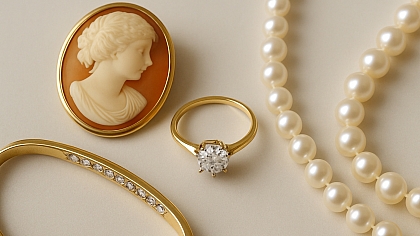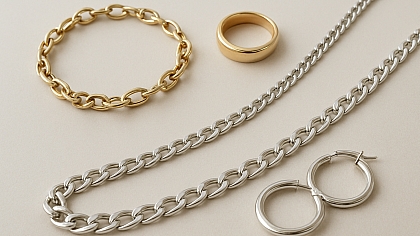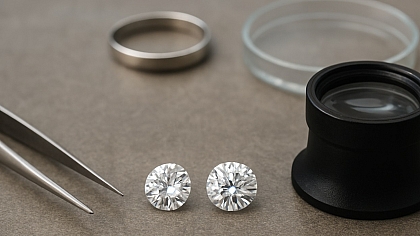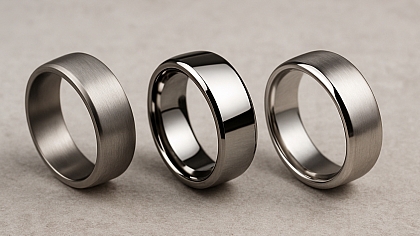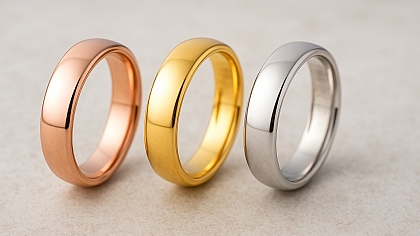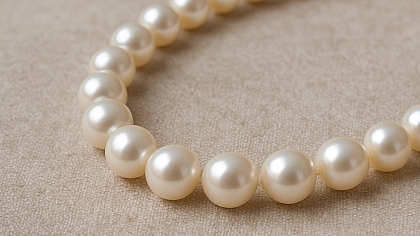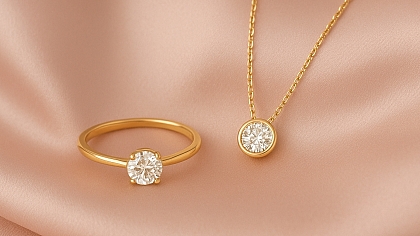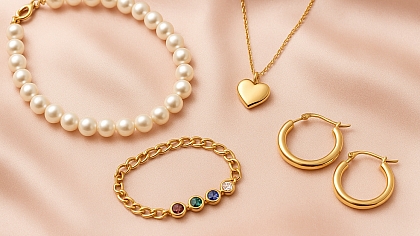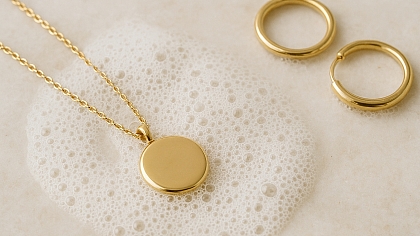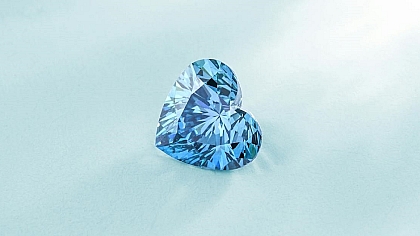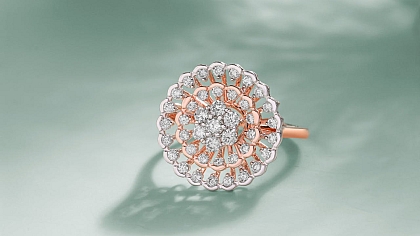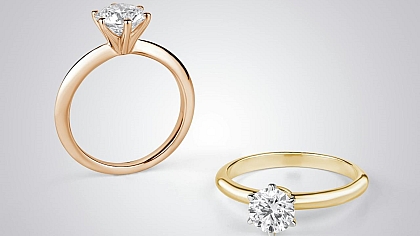
The Science of Gemstones Part 2: Enhancements and Treatments
In continuation of The Science of Gemstones Part 1, this subsequent section will unveil additional insights into the enhancements, maintenance, and factors to consider when purchasing these stunning gemstones.
Gemstones often use Enhancements and treatments to improve their appearance, durability, and marketability. These processes can alter a gemstone's colour, clarity, and overall quality, making it more appealing to consumers. However, treatments can also impact a gemstone's value and care requirements.
We will explore the various methods used to enhance gemstones, the reasons behind these treatments, and their implications for buyers and collectors.
Types of Enhancements and Treatments
Various techniques are employed to enhance the natural beauty of gemstones. Each method aims to address specific issues such as colour uniformity, clarity, or structural integrity.
Heat Treatment
Heat treatment is one of the most common methods used to enhance the colour and clarity of gemstones. This process involves heating the gemstone to high temperatures, which can alter its internal structure and improve its appearance.
- Purpose: Heat treatment can intensify or change the colour of gemstones, remove or reduce inclusions, and improve overall clarity. For example, sapphires and rubies are often heat-treated to enhance their colour and clarity.
- Process: The gemstone is heated to temperatures ranging from 500 to over 2000 degrees Celsius. The duration and specific temperature depend on the desired effect and the type of gemstone.
- Implications: Heat-treated gemstones are generally stable and require no special care. However, buyers should be informed of any heat treatment, as untreated stones can be more valuable.
Chemical Treatments
Chemical treatments involve the use of chemicals to alter the colour or clarity of a gemstone. These treatments can include dyeing, bleaching, or using chemical solutions to fill fractures.
- Dyeing: Dyeing is used to enhance or change the colour of a gemstone. Commonly dyed gemstones include turquoise, jade, and agate. The dye can penetrate surface fractures or be applied to the entire stone.
- Bleaching: Bleaching can lighten the colour of a gemstone or remove unwanted colour elements. Pearls, for example, are often bleached to achieve a uniform colour.
- Fracture Filling: Fracture filling involves filling cracks or fissures in a gemstone with a glass-like substance or resin. This treatment improves the gemstone's clarity and appearance. Commonly treated stones include emeralds and diamonds.
Irradiation
Irradiation uses high-energy radiation to change the colour of a gemstone. This treatment can create or enhance colours that are not naturally present in the gemstone.
- Purpose: Irradiation can produce vibrant and unique colours in gemstones, such as turning colourless diamonds blue or brown, and enhancing the blue colour in topaz.
- Process: The gemstone is exposed to controlled amounts of radiation. This exposure alters the atomic structure of the gemstone, resulting in a colour change. Often, heat treatment is used in conjunction with irradiation to stabilize the colour.
- Implications: Irradiated gemstones are generally stable and safe for everyday wear. However, the process should be disclosed to buyers, as natural, untreated colours are typically more valued.
Surface Coating
Surface coating involves applying a thin layer of material to the surface of a gemstone to enhance its colour or add special effects such as iridescence or metallic sheen.
- Purpose: Surface coatings can dramatically change the appearance of a gemstone, adding vibrant colours or unique optical effects. Coated gemstones include mystic topaz, which has a rainbow-like surface coating.
- Process: A thin layer of material, such as titanium or a metallic compound, is applied to the gemstone's surface using techniques like vapour deposition. The coating is usually very thin and affects only the surface appearance.
- Implications: Surface-coated gemstones require special care to avoid damaging the coating. Buyers should be aware that the coating can wear off over time, affecting the gemstone's appearance.
Ethical Considerations and Disclosure
Treatments and enhancements raise important ethical considerations in the gemstone industry. Transparency and disclosure are critical to maintaining trust between sellers and buyers.
- Disclosure Requirements: Reputable dealers and gemological organizations require full disclosure of any treatments or enhancements applied to gemstones. This information should be provided to buyers, allowing them to make informed decisions.
- Ethical Practices: Ethical practices in gemstone treatment include proper labelling, providing certificates of authenticity, and ensuring that treated gemstones are not misrepresented as natural or untreated.
- Impact on Value: Treatments can affect the value of a gemstone. While some treatments, like heat treatment, are widely accepted and may not significantly impact value, others, like dyeing or fracture filling, can reduce the gemstone's market value.
Care and Maintenance of Treated Gemstones
Treated gemstones may require specific care to maintain their appearance and durability. Understanding the type of treatment and its implications is essential for proper gemstone care.
- Heat-Treated Gemstones: Generally stable and durable, requiring no special care beyond regular cleaning with mild soap and water.
- Chemically Treated Gemstones: May be more sensitive to chemicals and heat. Avoid harsh cleaning agents and prolonged exposure to sunlight or extreme temperatures.
- Irradiated Gemstones: Typically stable, but some colours may fade with prolonged exposure to sunlight. Store in a dark, cool place when not in use.
- Surface-Coated Gemstones: Require gentle handling to avoid scratching or damaging the coating. Use a soft cloth for cleaning and avoid abrasive cleaners or ultrasonic cleaners.
Enhancements and treatments play a significant role in the gemstone industry, offering opportunities to improve the appearance and value of gemstones. However, buyers must be aware of these treatments and their implications, ensuring transparency and ethical practices in the market.
Evaluating and Purchasing Sparkling Gemstones
Purchasing sparkling gemstones requires a discerning eye and a thorough understanding of the factors that contribute to their brilliance, quality, and value. It helps to know how to evaluate gemstones, the key considerations when making a purchase, and tips for ensuring you select the best stone for your needs and preferences.
Understanding the Four Cs
The Four Cs – Cut, Colour, Clarity, and Carat Weight – are the primary criteria used to evaluate gemstones, particularly diamonds. Each of these factors plays a crucial role in determining the overall quality and value of a gemstone.
Cut
- Importance of Cut: The cut of a gemstone affects its brilliance and sparkle. A well-cut gemstone reflects light internally and externally, creating maximum brightness.
- Quality of Cut: Evaluate the proportions, symmetry, and polish of the gemstone. Ideal proportions and excellent symmetry enhance light performance, while a high-quality polish ensures a smooth surface for optimal reflection.
- Types of Cuts: Familiarize yourself with different cuts such as round brilliant, princess, emerald, and cushion. Each cut offers a unique appearance and level of brilliance.
Colour
- Colour Grading: Gemstones are graded based on hue, tone, and saturation. High-quality gemstones exhibit a pure hue with vibrant saturation and balanced tone.
- Colour Preferences: Consider personal preferences and the specific type of gemstone. For example, vivid blue sapphires and deep red rubies are highly prized, while some gemstones are valued for their unique colour-changing properties.
- Impact on Value: Intense, evenly distributed colour enhances the gemstone's value. Be aware that some treatments can improve colour but may affect the stone's natural value.
Clarity
- Clarity Grading: Clarity refers to the presence of inclusions (internal flaws) and blemishes (surface flaws). Gemstones are graded based on the number, size, and visibility of these imperfections.
- Impact on Appearance: High clarity allows more light to pass through the gemstone, enhancing its brilliance and sparkle. Inclusions can interfere with light performance and reduce overall beauty.
- Acceptable Inclusions: Some gemstones, like emeralds, commonly have inclusions and are still highly valued. Understanding the typical clarity standards for each gemstone type is essential.
Carat Weight
- Definition: Carat weight measures the size of a gemstone. One carat is equivalent to 200 milligrams.
- Impact on Value: Larger gemstones are rarer and generally more valuable, but other factors like cut, colour, and clarity significantly affect overall value.
- Balance of Size and Quality: When purchasing, consider the balance between carat weight and quality factors (cut, colour, and clarity) to ensure the best value for your budget.
Additional Evaluation Factors
Beyond the Four Cs, other factors can influence the value and appeal of a gemstone.
Gemstone Origin
- Provenance: The origin of a gemstone can affect its value and desirability. Gemstones from certain regions, like Burmese rubies or Colombian emeralds, are often more highly prized.
- Certification: Certificates from reputable gemological laboratories can verify the origin and authenticity of a gemstone. Ensure the certificate includes detailed information about the gemstone's characteristics.
Optical Phenomena
- Unique Effects: Optical phenomena like chatoyancy, asterism, and colour change can add significant value and interest to a gemstone. Understanding these effects and their causes can enhance appreciation and selection.
- Evaluating Phenomena: Observe the gemstone under different lighting conditions to fully appreciate and evaluate any optical phenomena it may exhibit.
Purchasing Tips and Best Practices
When purchasing a sparkling gemstone, consider the following tips and best practices to ensure you make an informed and satisfying choice.
Research and Education
- Learn the Basics: Familiarize yourself with the basics of gemstone evaluation, including the Four Cs and common optical phenomena. Understanding these principles will help you make more informed decisions.
- Gemstone Specifics: Research the specific type of gemstone you are interested in. Different gemstones have unique characteristics and grading standards.
Buy from Reputable Sources
- Trusted Retailers: Purchase from reputable jewellers and dealers with a history of ethical practices and positive customer reviews.
- Certified Gemstones: Look for gemstones that come with certificates from recognized gemological laboratories, ensuring their authenticity and quality.
Ask Questions
- Treatment Disclosure: Inquire about any treatments or enhancements applied to the gemstone. Understand how these treatments affect the stone's value and care requirements.
- Return Policy: Ensure the retailer has a clear return policy in case the gemstone does not meet your expectations or needs.
Inspect the Gemstone
- In-Person Inspection: Whenever possible, inspect the gemstone in person. Observe its colour, clarity, and brilliance under different lighting conditions.
- Use Tools: Use tools like a loupe or magnifying glass to closely examine the gemstone for inclusions, blemishes, and overall quality.
Caring for Your Gemstone
Proper care and maintenance are essential to preserve the beauty and value of your gemstone.
Cleaning
- Gentle Cleaning: Clean your gemstone regularly with mild soap and water, using a soft brush to remove dirt and grime. Avoid harsh chemicals and abrasive cleaners.
- Ultrasonic Cleaners: Use ultrasonic cleaners cautiously, as they can damage certain gemstones and treatments. Consult with a jeweller before using one.
Storage
- Safe Storage: Store gemstones separately to prevent scratching and damage. Use soft pouches or lined jewellery boxes to protect each piece.
- Avoid Sunlight: Prolonged exposure to sunlight can fade some gemstones. Store them in a dark, cool place when not in use.
Regular Inspections
- Professional Checkups: Have your gemstones inspected regularly by a professional jeweller to check for loose settings, wear, or damage.
- Repolishing: Over time, gemstones may require repolishing to restore their surface and brilliance. Consult with a jeweller for professional repolishing services.
Evaluating and purchasing sparkling gemstones involves a combination of knowledge, careful inspection, and trusted sources. By understanding the key factors that contribute to a gemstone's quality and value, you can make informed decisions and select beautiful, high-quality gemstones that will be cherished for years to come.
Caring for Your Gemstone Jewellery
Proper care and maintenance are crucial to preserving the beauty, brilliance, and longevity of your gemstone jewellery. Gemstones, while durable, can still be vulnerable to damage from environmental factors, improper handling, and everyday wear.
Cleaning Your Gemstone Jewellery
Regular cleaning is essential to maintain the sparkle and appearance of your gemstone jewellery. Over time, dirt, oils, and other residues can dull the surface and reduce the brilliance of your gemstones.
Gentle Cleaning Techniques
- Soap and Water: The safest and most effective method for cleaning most gemstone jewellery is using mild soap and warm water. Soak the jewellery for a few minutes, then gently scrub with a soft brush to remove dirt and grime. Rinse thoroughly and pat dry with a soft cloth.
- Avoid Harsh Chemicals: Harsh chemicals and abrasive cleaners can damage gemstones and metals. Avoid using household cleaners, bleach, or ammonia on your jewellery.
- Ultrasonic Cleaners: Ultrasonic cleaners use high-frequency sound waves to clean jewellery. While effective, they can damage certain gemstones (e.g., emeralds, opals) and treated stones. Consult with a jeweller before using an ultrasonic cleaner on your gemstone jewellery.
Professional Cleaning
- Jeweller Services: For a thorough and safe cleaning, take your jewellery to a professional jeweller. They have the expertise and tools to clean and inspect your pieces without causing damage.
- Regular Maintenance: Schedule regular cleaning and maintenance check-ups with your jeweller to ensure your jewellery remains in excellent condition.
Storing Your Gemstone Jewellery
Proper storage is essential to prevent damage and maintain the beauty of your gemstone jewellery. Incorrect storage can lead to scratches, chips, and other damage.
Individual Storage
- Separate Compartments: Store each piece of jewellery in a separate compartment or pouch to prevent them from scratching each other. Use soft-lined jewellery boxes or individual fabric pouches.
- Avoid Tangling: Chains and necklaces can become tangled and knotted. Store them in a way that prevents tangling, such as hanging them on hooks or storing them in individual slots.
Environmental Considerations
- Avoid Sunlight: Prolonged exposure to sunlight can fade the colour of some gemstones, such as amethyst and topaz. Store your jewellery in a dark, cool place when not in use.
- Control Humidity: Excessive humidity can damage certain gemstones and metals. Store your jewellery in a dry place, and consider using silica gel packets to absorb moisture in your storage area.
Wearing Your Gemstone Jewellery
How you wear and handle your gemstone jewellery can significantly impact its longevity and appearance.
Everyday Care
- Remove During Activities: Remove your jewellery during activities that could expose it to rough handling, chemicals, or impact, such as gardening, swimming, or exercising.
- Apply Cosmetics First: Apply lotions, perfumes, and cosmetics before putting on your jewellery to prevent exposure to chemicals that can damage gemstones and metals.
Handling and Inspection
- Handle with Care: Always handle your jewellery with clean hands and avoid touching the gemstones as much as possible to prevent transferring oils and dirt.
- Regular Inspections: Regularly inspect your jewellery for any signs of damage or wear, such as loose settings, scratches, or chips. Promptly address any issues to prevent further damage.
Special Care for Treated Gemstones
Gemstones that have undergone treatments may require special care to maintain their appearance and stability.
Heat-Treated Gemstones
- Stable but Careful: Heat-treated gemstones are generally stable, but it's still essential to avoid extreme temperature changes and harsh chemicals.
Chemically Treated Gemstones
- Avoid Harsh Cleaners: Chemically treated gemstones, such as dyed or fracture-filled stones, should be cleaned with mild soap and water only. Avoid ultrasonic cleaners and steam cleaners.
- Limit Sun Exposure: Some chemically treated gemstones can be sensitive to sunlight and may fade over time. Store them in a dark place when not in use.
Surface-Coated Gemstones
- Gentle Handling: Surface-coated gemstones require extra care to avoid scratching or wearing away the coating. Clean them gently with a soft cloth and mild soap.
- Avoid Abrasives: Do not use abrasive materials or cleaners on surface-coated gemstones, as this can damage the coating.
Professional Maintenance and Repairs
Regular professional maintenance and prompt repairs are vital to ensure the longevity and beauty of your gemstone jewellery.
Regular Check-Ups
- Annual Inspections: Take your jewellery to a professional jeweller at least once a year for an inspection. They can check for loose settings, worn prongs, and other potential issues.
- Repolishing: Over time, gemstones and metals can become scratched or dulled. Professional repolishing can restore their original brilliance and smoothness.
Prompt Repairs
- Address Issues Immediately: If you notice any damage, such as a loose stone or broken clasp, have it repaired immediately to prevent further damage or loss.
- Trustworthy Jewellers: Choose a reputable jeweller for repairs to ensure quality workmanship and the use of appropriate materials.
Caring for your gemstone jewellery involves a combination of regular cleaning, careful storage, mindful wearing, and professional maintenance. By following these guidelines, you can preserve the beauty and brilliance of your gemstones for years to come, ensuring they remain treasured pieces in your collection.
Understanding the science behind what makes gemstones sparkle, their enhancements and treatments, and how to evaluate and care for them is essential for any jewellery enthusiast or collector. The brilliance and allure of gemstones are the result of a complex interplay of their physical and chemical properties, as well as the skilled craftsmanship that brings out their best qualities.
Key Points
-
The Science of Sparkle: The unique structure and composition of gemstones, along with precise cutting techniques, contribute to their scintillating sparkle. Light interaction, including refraction, reflection, and dispersion, plays a crucial role in creating the visual effects that make gemstones so captivating.
-
Enhancements and Treatments: Many gemstones undergo various treatments to enhance their natural beauty and durability. Common methods include heat treatment, chemical treatments, irradiation, and surface coating. Understanding these treatments and their implications is essential for making informed purchasing decisions and maintaining the value of your gemstones.
-
Evaluating Gemstones: The Four Cs – Cut, Colour, Clarity, and Carat Weight – are fundamental criteria for evaluating gemstones, especially diamonds. Additional factors, such as gemstone origin and optical phenomena, also influence value and appeal. Knowledge of these factors enables buyers to select high-quality gemstones that meet their preferences and budget.
-
Purchasing Tips: When buying gemstones, research and education are paramount. Purchasing from reputable sources, asking about treatments, and carefully inspecting the gemstones are critical steps to ensure you get the best value and quality.
-
Caring for Gemstone Jewellery: Proper care, including regular cleaning, careful storage, and mindful wearing, preserves the beauty and longevity of gemstone jewellery. Professional maintenance and repairs further ensure that your jewellery remains in excellent condition.
The Importance of Knowledge and Expertise
Possessing knowledge about gemstones enhances your appreciation and enjoyment of their unique qualities. Whether you are a seasoned collector or a casual jewellery lover, understanding the factors contributing to gemstones' brilliance and value empowers you to make confident and informed decisions. It also fosters an appreciation for the craftsmanship and artistry involved in creating stunning gemstone jewellery.
Enjoying Your Sparkling Gemstones
With the right care and knowledge, your gemstone jewellery can continue to sparkle and bring joy for many years. Whether you're adding to your collection or caring for a cherished heirloom, the effort you put into understanding and maintaining your gemstones will ensure they remain as beautiful and captivating as the day you acquired them.
Gemstones have fascinated and enchanted humans for centuries. Their allure lies not only in their natural beauty but also in the scientific marvels that make them sparkle and shine. You can fully enjoy and cherish your gemstone jewellery by combining an appreciation for its aesthetic qualities with a solid understanding of its scientific and evaluative aspects.
The science of gemstones, their enhancements and treatments, evaluation criteria, purchasing tips, and care practices are all integral to experiencing the full splendour of these precious treasures. Embrace the knowledge, invest in quality, and enjoy the timeless beauty of your sparkling gemstones.
